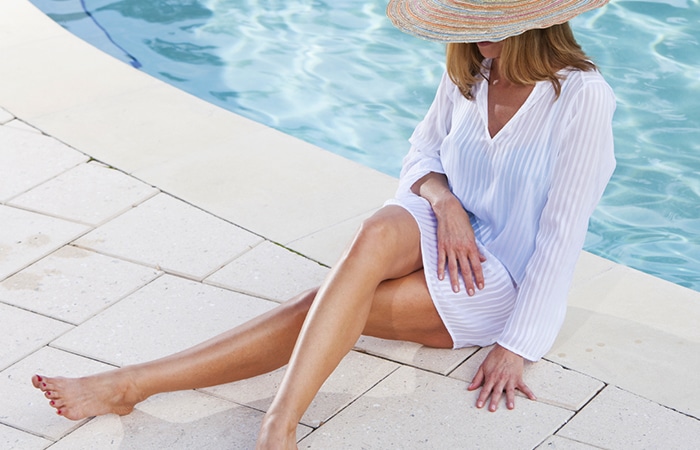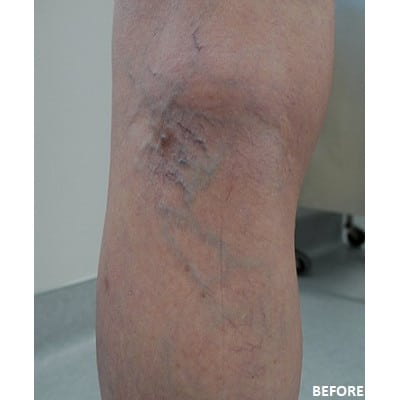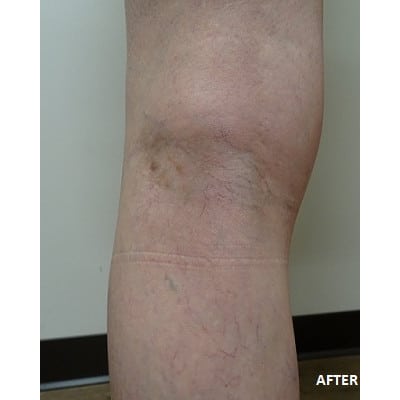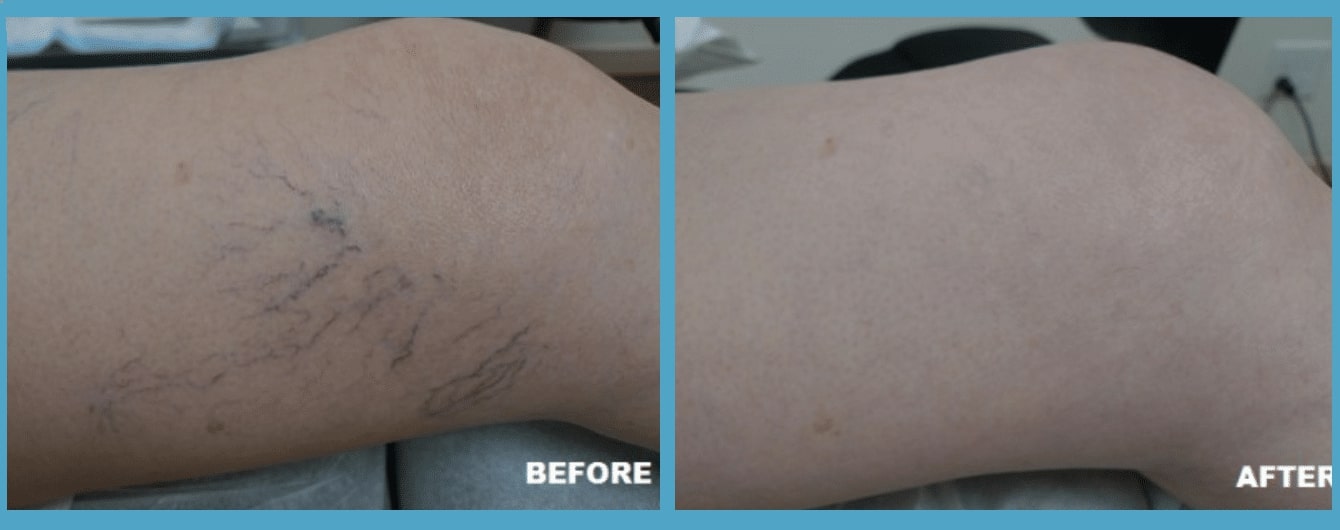
Approximately half of the women in America struggle with the appearance of spider veins. However, this problem is not experienced by just women; up to 45% of all men develop vein diseases like spider veins or varicose veins.
Spider veins are those localized clusters of purple, red, and blue veins that sit just beneath the skin.
Medically known as telangiectasia, is the “branching,” jagged appearance of veins, similar to webbing, hence being called spider veins. Spider veins can be problematic because they often develop in highly visible areas, such as the face or the legs. Additionally, many people notice that they seem to spread exponentially over the years, eventually covering larger areas. This is where a vascular doctor, such as Dr. Lee can help!
What causes spider veins?
The reason that spider veins develop is because blood backs up in a localized area. This is why we often see this problem in the lower extremities. Weakness in the vascular valves enables blood to pool in certain vessels. When this accumulation of blood occurs in smaller, superficial veins, we see the discolored webbing of the veins on the surface.
Causes of spider veins include:
- Prolonged sitting or standing on a regular basis, such as for work
- Genetic makeup
- Excess weight
- Pregnancy and other conditions that affect hormonal balance
- Sun exposure
No special diagnostic testing is typically necessary to identify spider veins. A physical examination and observation of the skin usually leads to an accurate diagnosis. However, diagnostic ultrasound may be recommended if a more extensive condition is suspected.
The presence of spider veins can be quite frustrating. Rather than hide your legs, we invite you to explore your treatment options at Los Angeles Vein Center in Sherman Oaks. Our team has the training and experience to remove your spider veins.
What treatment is available for spider veins?
Vein treatments have progressed with the development of innovative technologies. Still, one of the most popular spider vein treatments is also one of the oldest. At LA Vein Center, Dr. Lee often eliminates spider veins using sclerotherapy. This approach to unsightly veins causes closure by injecting an FDA-approved sclerosing medication into visible veins.
Regardless of the vein treatment selected, patients are usually advised to wear compression stockings for a day or two after their procedure. The gentle pressure of compression encourages the vein walls to stick, preventing blood from moving through.
Spider Vein Before & After


Is spider vein treatment painful?
Spider vein treatment is not intolerable but may be uncomfortable. There are no nerve endings in the veins. However, the surrounding nerves can pick up mild pain sensations. These may stem from the effects of the sclerosing agent. Because sclerotherapy is performed using a tiny needle, the injections themselves are virtually painless. Patients feel the minor pinprick sensation associated with injections but this is only temporary. It is beneficial to receive vein treatment from a board-certified vein specialist like Dr. Lee, who has various strategies for improving comfort.
Are there any risks or complications of spider vein treatment?
There are few risks involved in the vein treatments that are common today. Most procedures are well tolerated and successful in reaching the intended outcome. That said, patients should be aware of risks such as allergic reaction to the sclerosing agent and the spread of the drug to surrounding tissues. The most common side effect associated with sclerotherapy is hyperpigmentation in the skin. This usually resolves over time.
Sclerotherapy for Spider Veins
The most common procedure used to eliminate spider veins is sclerotherapy. The non-surgical treatment promotes vein closure by introducing a medicated substance into these vessels. Using a tiny needle, Dr. Lee injects the sclerosing agent into superficial vessels in a short office visit. As the substance comes into contact with vessel walls, controlled damage occurs and the vein gradually closes. Over time, these veins become less noticeable until, ultimately, they disappear. Depending on the extent of the problem, multiple sessions may be scheduled.
Because spider veins are largely a cosmetic issue, it is uncommon for treatment to be covered by insurance. The rare exception is when a vein has begun to bleed. In such instances, insurance will likely cover treatment of the bleeding vein, but not others.
Who typically gets spider veins
Spider veins are not completely understood by the medical community. We cannot predict who will get them and who will not. However, research has shown that the development of these tiny webs of visible veins may be influenced by several factors. These include:
- Age. It is believed that the risk of spider veins may increase with age simply because the valves in our veins age right along with the rest of the body. Weaker veins mean a greater likelihood of developing visible problems.
- Family history. While not fully understood, a family history of vein problems seems to increase a person’s risk of developing spider veins and varicose veins.
- Lifestyle habits. One of the controllable factors related to spider veins is the amount of movement a person performs every day. Those who are more sedentary, who work at a desk and do not balance sitting with standing, stretching, and walking or other forms of exercise, are more likely to experience vein problems.
- Hormones. The female hormone estrogen can cause weakness in the valves of veins, which is one reason women are more likely to experience this condition.
- Obesity. While thinner people may develop spider veins, experts say that we are more likely to see them in people who are heavier than is ideal for their frame. There could be several reasons for this relationship between weight and spider veins. One is that excess weight places more pressure on the lower extremities than is ideal for optimal circulation. Another is that people who are overweight may be more sedentary.
- UV exposure. The ultraviolet light in sunshine and in tanning beds doesn’t just break down healthy collagen but also affects superficial veins. The resulting weakness caused by sun damage can cause spider veins.
Can spider veins cause leg swelling or pain?
In most cases, symptoms related to spider veins revolve around appearance. The discoloration and webbed matrix of superficial veins is usually difficult to disguise. In some cases, patients have reported feeling sensations such as swelling, burning, itching, or aching stemming from spider veins.
Who is a candidate to undergo treatment?
Most adults are good candidates for the vein treatments offered in our Sherman Oaks facility, with only a few exceptions. For example, vein treatments are not performed on pregnant women. The reason being that some spider veins and varicose veins may resolve spontaneously within a year of childbirth. Adults with clotting issues or who are taking blood thinners or certain other medications may also not be good candidates for vein treatments. Dr. Lee performs a comprehensive medical history and consultation to ensure patients receive the safest, most effective care.
To be a good candidate for vein treatment, a patient should have realistic expectations of what can be achieved. No vein treatment can completely eliminate every visible vein. While our therapies are very effective, there is also no way to prevent new spider veins from forming in the future. Vein treatments are not necessarily once-and-done. Repeat sessions may be needed from time to time to address new veins that develop.
What our patients say
"Dr. Lee is one of the most qualified specialist in veins that I have ever known. I have been suffering my whole life since I was a teenage with my legs being really tired and full of spider veins, and I saw many Doctors and they just said that my problem was aesthetic, it was something more serious, my internal veins were damaged. Now after the Ablation performed by Dr. Lee, I have so much relief. Feels like I have new legs and I am so happy, also I have experienced an excellent professionalism and a great deal of humane warmth and caring atmosphere, no just from Dr. Lee, but from all her staff. I has been a wonderful experience and the results have been awesome. I would not hesitate to recommend Dr. Lee to any of my friends because she is very special."
Can spider veins recur?
Once spider veins have been treated, they are gone forever. However, new clusters of visible veins may appear in other areas. To decrease the risk of recurrence, it is beneficial to implement healthy lifestyle habits such as long-term weight management, sun protection, and frequent movement throughout the day.
Does insurance cover spider vein treatments?
Typically, spider vein treatment is conducted for cosmetic improvement. Insurance coverage is usually available only for the treatment of veins that are symptomatic, meaning they present physical issues such as skin ulcers. We participate in a number of insurance plans. Financing options are also available. For more information on insurance for vein treatments, contact our office or your insurance company.
How long does treatment take?
The duration of spider vein treatment depends on the extent of the problem to be treated. Patient tolerance for treatment is also taken into consideration. Many of the treatments we perform are concluded within 30 minutes to one hour. During this time, we are mindful of your comfort and do everything we can to make your experience a positive one.

Recovery Time After They Are Removed
The most common modality for treating spider veins are sclerotherapy. Patients are able to resume light activity following spider vein treatment. Walking is even encouraged due to its support of healthy blood flow. If slight discomfort occurs after treatment, compression stockings may be worn to place gentle pressure on the legs as veins gradually collapse and absorb into surrounding tissue.
Can spider veins be prevented?
Because spider veins may result from a number of factors, there is no guarantee of prevention using diet, exercise, or lifestyle modifications. However, there are steps you can take such as moving frequently, going for walks or becoming more active, wearing comfortable shoes, and maintaining a healthy weight can reduce the risk factors. Individuals who are prone to spider veins may want to consider wearing compression stockings to minimize their risk of new veins.
Are spider veins related to varicose veins?
Spider veins and varicose veins do share some of the same risk factors, such as standing or sitting for prolonged periods. However, they differ in how they may be treated and in how they present in the body. Spider veins are more delicate than varicose veins and are less likely to cause physical discomfort. Their appearance, in small clusters, is quite different than the average varicose vein, which bulges against the skin.
In our office located at Sherman Oaks Medical Plaza, we can help you find the solutions you need to improve the appearance and comfort of your skin. Dr. Lee is a sought-after vein specialist who serves patients from the Los Angeles area in a comfortable, professional environment.
Schedule a Client Consultation
The team at LA Vein Center understands the distress that spider veins can cause. We are here to help. Schedule your visit with us at (818) 325-0400.
Contact our Los Angeles office to learn more about our Spider Vein services, or to make an appointment.



